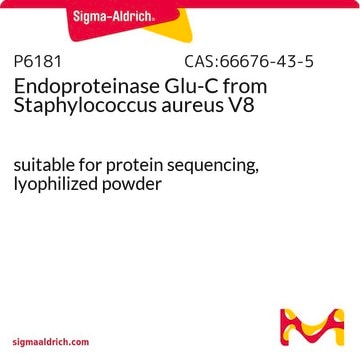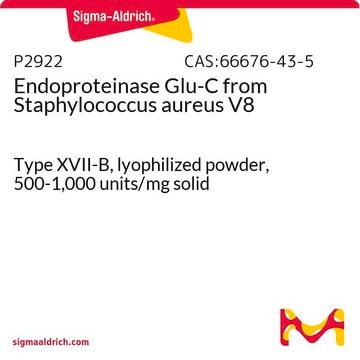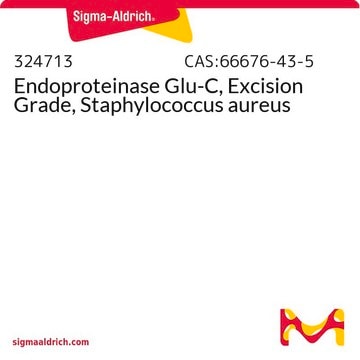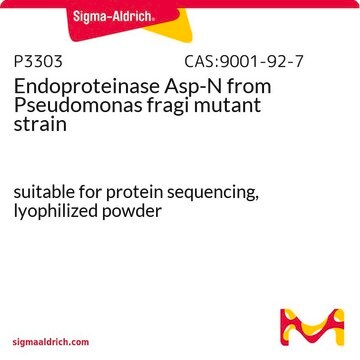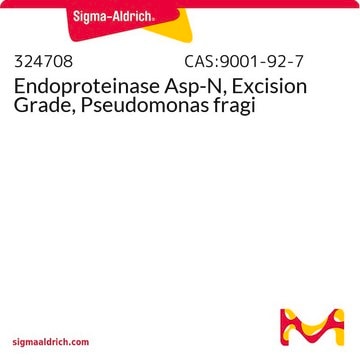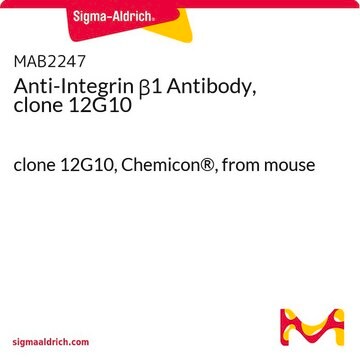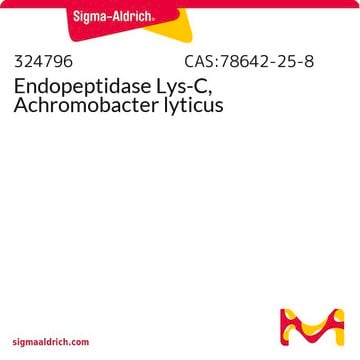10791156001
Roche
Endoproteinase Glu-C (V8 Protease)
from Staphylococcus aureus V8
Sinónimos:
V8 protease, protease v8
Iniciar sesiónpara Ver la Fijación de precios por contrato y de la organización
About This Item
Productos recomendados
form
lyophilized (salt-free)
specific activity
20 U/mg
mol wt
30 kDa
packaging
pkg of 2 mg
manufacturer/tradename
Roche
optimum pH
8.0-8.5
Categorías relacionadas
General description
Approximately 20 U/mg lyophilizate at +25°C with Z-Phe-Leu-Glu-4-nitranilide as the substrate (approximately 500 U/mg lyophilizate at +37°C with casein as the substrate).
At 25 °C with Z-Phe-Leu-Glu-4-nitranilide as the substrate (approximately 500 U/mg lyophilizate at 37 °C with casein as the substrate).
Endoproteinase Glu-C is a Staphylococcal serine proteinase. Its inhibitors are DFP, α2-macroglobulin and TLCK.
Specificity
Heat inactivation: Endoproteinase Glu-C is inactivated by boiling for ten minutes.
Application
Use Endoproteinase Glu-C (V8 Protease) for protein structure analysis and for sequence analysis.
Biochem/physiol Actions
Endoproteinase Glu-C specifically hydrolyzes peptide and ester bonds at the carboxylic side of Glu, or both Glu and Asp, depending on the buffer used.
Preparation Note
Activator: The enzyme has its maximal activity in presence of SH-reagents
Working concentration: 1 to 5 mM
Working solution: Recommended solvent is 50 mM ammonium acetate pH 4.0 (2 mg/ml).
Storage conditions (working solution): -15 to -25 °C
The enzyme (2 mg/ml in 50 mM ammonium acetate, pH 4.0) is stable for at least one month, frozen in aliquots and thawed only once.
Working concentration: 1 to 5 mM
Working solution: Recommended solvent is 50 mM ammonium acetate pH 4.0 (2 mg/ml).
Storage conditions (working solution): -15 to -25 °C
The enzyme (2 mg/ml in 50 mM ammonium acetate, pH 4.0) is stable for at least one month, frozen in aliquots and thawed only once.
Storage and Stability
Store at 2 to 8 °C. (Store dry!)
Other Notes
For life science research only. Not for use in diagnostic procedures.
signalword
Danger
hcodes
Hazard Classifications
Eye Irrit. 2 - Resp. Sens. 1 - Skin Irrit. 2 - STOT SE 3
target_organs
Respiratory system
Storage Class
11 - Combustible Solids
wgk_germany
WGK 1
flash_point_f
does not flash
flash_point_c
does not flash
Certificados de análisis (COA)
Busque Certificados de análisis (COA) introduciendo el número de lote del producto. Los números de lote se encuentran en la etiqueta del producto después de las palabras «Lot» o «Batch»
¿Ya tiene este producto?
Encuentre la documentación para los productos que ha comprado recientemente en la Biblioteca de documentos.
Los clientes también vieron
Neha Garg et al.
Biopolymers, 106(6), 834-842 (2016-05-15)
The biosynthesis of the class II lanthipeptide geobacillin II was reconstituted in vitro. The purified precursor peptide was modified by the lanthipeptide synthetase GeoM at temperatures ranging between 37 and 80°C demonstrating the thermostability of the enzyme. Geobacillin II shares
Petr Pompach et al.
Journal of proteome research, 11(3), 1728-1740 (2012-01-14)
Glycoproteins fulfill many indispensable biological functions, and changes in protein glycosylation have been observed in various diseases. Improved analytical methods are needed to allow a complete characterization of this complex and common post-translational modification. In this study, we present a
Marion Avril et al.
PLoS pathogens, 9(6), e1003430-e1003430 (2013-07-05)
During blood stage infection, Plasmodium falciparum infected erythrocytes (IE) bind to host blood vessels. This virulence determinant enables parasites to evade spleen-dependent killing mechanisms, but paradoxically in some cases may reduce parasite fitness by killing the host. Adhesion of infected
Rosalynn C Molden et al.
Current protocols in protein science, 77, 23-23 (2014-08-02)
Histones are chromatin proteins that are highly modified with many different types of post-translational modifications. These modifications act in concert to regulate a number of chromatin-related processes. However, identification and quantification of co-occurring histone post-translational modifications is challenging because there
Tianshi Wang et al.
Molecular cell, 75(4), 823-834 (2019-07-16)
Sirt3, as a major mitochondrial nicotinamide adenine dinucleotide (NAD)-dependent deacetylase, is required for mitochondrial metabolic adaption to various stresses. However, how to regulate Sirt3 activity responding to metabolic stress remains largely unknown. Here, we report Sirt3 as a SUMOylated protein in
Nuestro equipo de científicos tiene experiencia en todas las áreas de investigación: Ciencias de la vida, Ciencia de los materiales, Síntesis química, Cromatografía, Analítica y muchas otras.
Póngase en contacto con el Servicio técnico